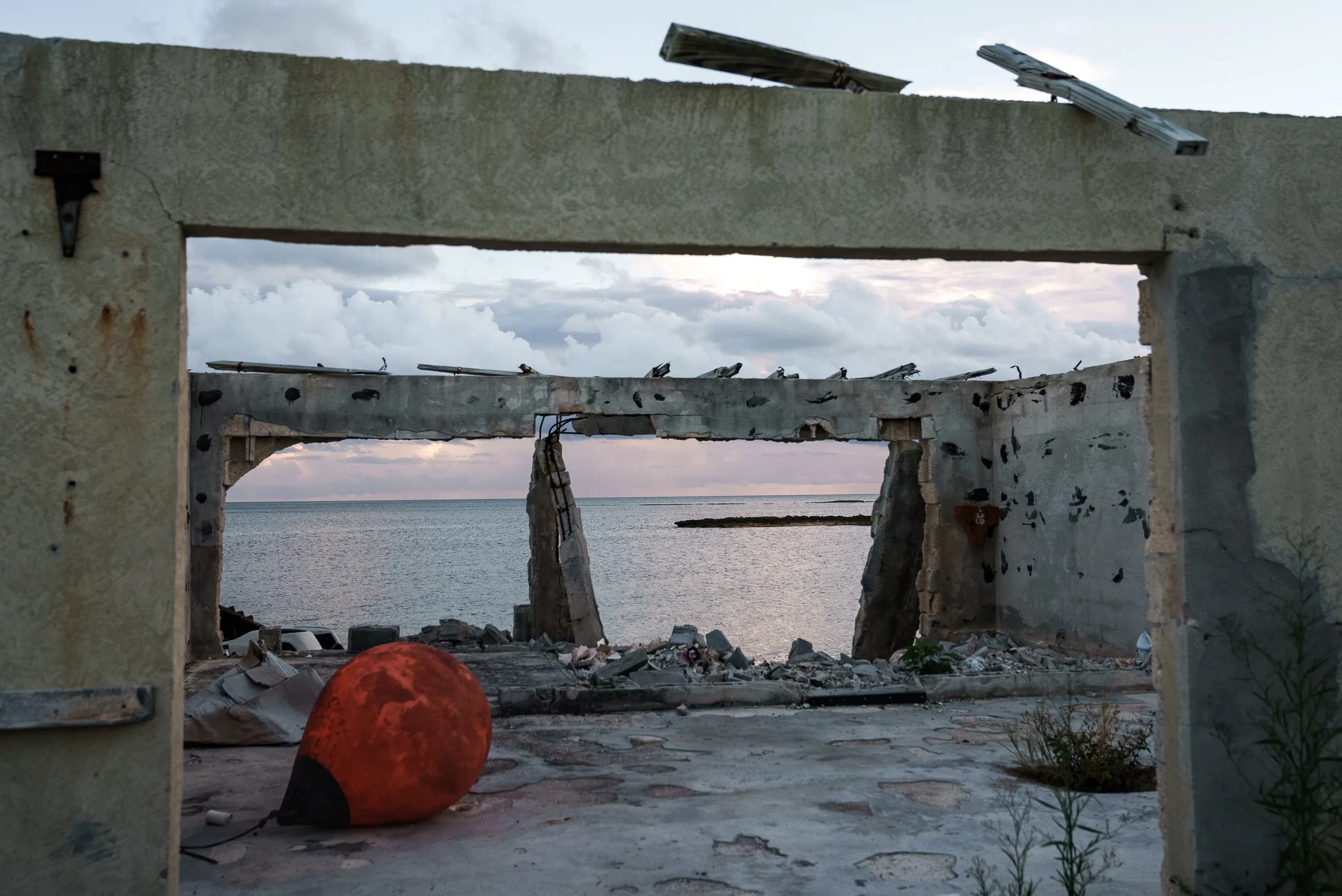

STORY
5
.
3
Resilient Cities
Large cities could attract climate mobility while smaller ones might act as hubs for people moving abroad.



STORY
5
.
3
Resilient Cities
Large cities could attract climate mobility while smaller ones might act as hubs for people moving abroad.



STORY
5
.
3
Resilient Cities
Large cities could attract climate mobility while smaller ones might act as hubs for people moving abroad.

The cities of the Greater Caribbean region have long provided refuge and a place to resettle.
The cities of the Greater Caribbean region have long provided refuge and a place to resettle.
The cities of the Greater Caribbean region have long provided refuge and a place to resettle.
A rush of rural-urban migration starting in the 1980s has fueled population growth in cities, particularly in Mexico and Central America. Cities continue to be important destinations for climate mobility, offering economic opportunities away from agriculture.
A rush of rural-urban migration starting in the 1980s has fueled population growth in cities, particularly in Mexico and Central America. Cities continue to be important destinations for climate mobility, offering economic opportunities away from agriculture.
A rush of rural-urban migration starting in the 1980s has fueled population growth in cities, particularly in Mexico and Central America. Cities continue to be important destinations for climate mobility, offering economic opportunities away from agriculture.
Finding work in the city is a strategy, usually pursued by young men, to diversify family incomes. In Colombia and Costa Rica, this practice is common, both as a temporary stopgap and permanent arrangement. For others, like hurricane survivors in the Bahamas, moving to the city is a last resort after their homes were damaged beyond repair.
Future climate change will amplify these movement patterns. Over the next several decades, more diversified economies will insulate large cities from the worst impacts of climate change and make them comparatively more resilient. Unsurprisingly, they are projected to become the resettlement option of choice for people leaving rural areas. The region’s 11 largest cities are all projected to be key climate mobility destinations.
Across Central America, with the exception of Belize, more people are expected to arrive in metropolitan areas than leave them. The same is true for Colombia. The region’s major cities will thus be confronted with the dual challenge of adapting to climate change and meeting the needs of current residents while planning for future population growth and the inclusion of newcomers.
Finding work in the city is a strategy, usually pursued by young men, to diversify family incomes. In Colombia and Costa Rica, this practice is common, both as a temporary stopgap and permanent arrangement. For others, like hurricane survivors in the Bahamas, moving to the city is a last resort after their homes were damaged beyond repair.
Future climate change will amplify these movement patterns. Over the next several decades, more diversified economies will insulate large cities from the worst impacts of climate change and make them comparatively more resilient. Unsurprisingly, they are projected to become the resettlement option of choice for people leaving rural areas. The region’s 11 largest cities are all projected to be key climate mobility destinations.
Across Central America, with the exception of Belize, more people are expected to arrive in metropolitan areas than leave them. The same is true for Colombia. The region’s major cities will thus be confronted with the dual challenge of adapting to climate change and meeting the needs of current residents while planning for future population growth and the inclusion of newcomers.
Finding work in the city is a strategy, usually pursued by young men, to diversify family incomes. In Colombia and Costa Rica, this practice is common, both as a temporary stopgap and permanent arrangement. For others, like hurricane survivors in the Bahamas, moving to the city is a last resort after their homes were damaged beyond repair.
Future climate change will amplify these movement patterns. Over the next several decades, more diversified economies will insulate large cities from the worst impacts of climate change and make them comparatively more resilient. Unsurprisingly, they are projected to become the resettlement option of choice for people leaving rural areas. The region’s 11 largest cities are all projected to be key climate mobility destinations.
Across Central America, with the exception of Belize, more people are expected to arrive in metropolitan areas than leave them. The same is true for Colombia. The region’s major cities will thus be confronted with the dual challenge of adapting to climate change and meeting the needs of current residents while planning for future population growth and the inclusion of newcomers.
Figure 1
Under future climate change, primary cities (marked in blue) will likely gain population while secondary cities could lose population.
Map of Greater Caribbean cities that will gain population by 2050.
Source: GCCMI Greater Caribbean Climate Mobility Model, 2024.

Figure 1
Under future climate change, primary cities (marked in blue) will likely gain population while secondary cities could lose population.
Map of Greater Caribbean cities that will gain population by 2050.

Source: GCCMI Greater Caribbean Climate Mobility Model, 2024.
Figure 1
Under future climate change, primary cities (marked in blue) will likely gain population while secondary cities could lose population.
Map of Greater Caribbean cities that will gain population by 2050.

Source: GCCMI Greater Caribbean Climate Mobility Model, 2024.
Figure 2
Population growth in the greater Medellín area
Medellín, Colombia
Thousand
Home to several of the largest cities in the Greater Caribbean, Colombia could see over 650,000 people move into urban areas by 2050. This growth will mostly occur in its three largest cities, including Medellín, Cali, and Bogotá. As an economic stronghold with a temperate climate, the Medellín area is projected to be a key destination for people fleeing climate impacts.
People Arriving
Light blue circles represent people arriving due to climate change under the Rocky Road scenario (SSP3-RCP7.0) by 2050 (11 - 15,760 people). There is no significant out-migration due to climate change under the Rocky Road scenario (SSP3-RCP7.0) by 2050.




Figure 2
Population growth in the greater Medellín area
Medellín, Colombia
Thousand
Home to several of the largest cities in the Greater Caribbean, Colombia could see over 650,000 people move into urban areas by 2050. This growth will mostly occur in its three largest cities, including Medellín, Cali, and Bogotá. As an economic stronghold with a temperate climate, the Medellín area is projected to be a key destination for people fleeing climate impacts.
People Arriving
Light blue circles represent people arriving due to climate change under the Rocky Road scenario (SSP3-RCP7.0) by 2050 (11 - 15,760 people). There is no significant out-migration due to climate change under the Rocky Road scenario (SSP3-RCP7.0) by 2050.




Figure 2
Population growth in the greater Medellín area
Medellín, Colombia
Thousand
Home to several of the largest cities in the Greater Caribbean, Colombia could see over 650,000 people move into urban areas by 2050. This growth will mostly occur in its three largest cities, including Medellín, Cali, and Bogotá. As an economic stronghold with a temperate climate, the Medellín area is projected to be a key destination for people fleeing climate impacts.
People Arriving
Light blue circles represent people arriving due to climate change under the Rocky Road scenario (SSP3-RCP7.0) by 2050 (11 - 15,760 people). There is no significant out-migration due to climate change under the Rocky Road scenario (SSP3-RCP7.0) by 2050.




However, smaller cities could lose population due to climate impacts. Cities in the region - especially coastal ones - face their own climate challenges, including threats from sea-level rise, tropical cyclones, and droughts. Impervious infrastructure and building materials, as well as high housing informality heighten the risk of urban populations to hazards such as flooding.
Urban areas in some countries will serve as points of departure for cross-border mobility, as people flee climate damage and seek employment and education opportunities abroad. Across the Caribbean SIDS, Mexico, Belize, Suriname, and Guyana, urban populations are expected to decline as a result of the economic impacts of climate change.
However, smaller cities could lose population due to climate impacts. Cities in the region - especially coastal ones - face their own climate challenges, including threats from sea-level rise, tropical cyclones, and droughts. Impervious infrastructure and building materials, as well as high housing informality heighten the risk of urban populations to hazards such as flooding.
Urban areas in some countries will serve as points of departure for cross-border mobility, as people flee climate damage and seek employment and education opportunities abroad. Across the Caribbean SIDS, Mexico, Belize, Suriname, and Guyana, urban populations are expected to decline as a result of the economic impacts of climate change.
However, smaller cities could lose population due to climate impacts. Cities in the region - especially coastal ones - face their own climate challenges, including threats from sea-level rise, tropical cyclones, and droughts. Impervious infrastructure and building materials, as well as high housing informality heighten the risk of urban populations to hazards such as flooding.
Urban areas in some countries will serve as points of departure for cross-border mobility, as people flee climate damage and seek employment and education opportunities abroad. Across the Caribbean SIDS, Mexico, Belize, Suriname, and Guyana, urban populations are expected to decline as a result of the economic impacts of climate change.
Figure 3
The dual impact of climate mobility in the greater Barranquilla area
Barranquilla, Colombia
Thousand
Cities in Colombia will also continue to face their own climate challenges. As a result, over 354,000 people are projected to move away from smaller cities in Colombia. Located in a low-lying coastal area, Barranquilla and its surroundings are prone to extreme flooding. Although its port economy will likely continue to draw in-migrants, the Barranquilla area could see overall population decline due to climate change by mid-century.
People Arriving
People Leaving
Light blue circles represent people arriving due to climate change under the Rocky Road scenario (SSP3-RCP7.0) by 2050 (15 - 16,170 people). Dark blue circles represent people leaving due to climate change under the Rocky Road scenario (SSP3-RCP7.0) by 2050 (58 - 22,223 people).




Figure 3
The dual impact of climate mobility in the greater Barranquilla area
Barranquilla, Colombia
Thousand
Cities in Colombia will also continue to face their own climate challenges. As a result, over 354,000 people are projected to move away from smaller cities in Colombia. Located in a low-lying coastal area, Barranquilla and its surroundings are prone to extreme flooding. Although its port economy will likely continue to draw in-migrants, the Barranquilla area could see overall population decline due to climate change by mid-century.
People Arriving
People Leaving
Light blue circles represent people arriving due to climate change under the Rocky Road scenario (SSP3-RCP7.0) by 2050 (15 - 16,170 people). Dark blue circles represent people leaving due to climate change under the Rocky Road scenario (SSP3-RCP7.0) by 2050 (58 - 22,223 people).




Figure 3
The dual impact of climate mobility in the greater Barranquilla area
Barranquilla, Colombia
Thousand
Cities in Colombia will also continue to face their own climate challenges. As a result, over 354,000 people are projected to move away from smaller cities in Colombia. Located in a low-lying coastal area, Barranquilla and its surroundings are prone to extreme flooding. Although its port economy will likely continue to draw in-migrants, the Barranquilla area could see overall population decline due to climate change by mid-century.
People Arriving
People Leaving
Light blue circles represent people arriving due to climate change under the Rocky Road scenario (SSP3-RCP7.0) by 2050 (15 - 16,170 people). Dark blue circles represent people leaving due to climate change under the Rocky Road scenario (SSP3-RCP7.0) by 2050 (58 - 22,223 people).









